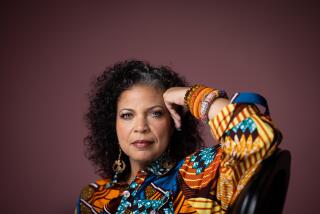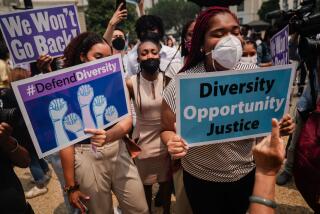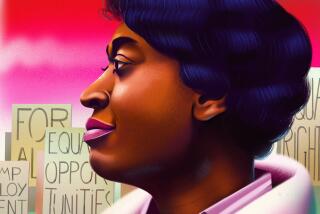Julian Bond
- Share via
WASHINGTON — Scandals big and small have besieged the venerable National Assn. for the Advancement of Colored People--established in 1909 under the leadership of scholar-activist W.E.B. DuBois--in the last few years. First, Benjamin F. Chavis Jr., was fired as executive director for using NAACP funds to help settle a sex discrimination and sexual harassment suit against himself. The next year, board chairman William F. Gibson was ousted because he used NAACP money for personal purposes. Another member was removed from the board after admitting pilfering $13,000 from a leukemia-stricken colleague. To try to set matters right, the NAACP tapped Myrlie Evers-Williams, widow of slain Mississippi civil-rights hero Medgar Evers, as board chairman and installed former Congressional Black Caucus chairman Kweisi Mfume as president.
When Evers-Williams stepped down in February, longtime civil-rights activist Julian Bond was elected to take her place. Bond comes from the student civil-rights movement of the 1960s, whose leaders often felt the NAACP dragged its feet and was no longer relevant, despite its history of court victories against segregation. Now he must help the NAACP meet increasingly complex racial challenges.
Bond, 58, is no stranger to conflict. He engineered civil-rights demonstrations in Atlanta while a college student, eventually dropping out of Morehouse College to work in the movement full time. Elected to the Georgia legislature at 25, he was not seated because of his opposition to the Vietnam War. He sued, charging violation of his First Amendment rights, and won. In 1968, he helped lead a challenge to Georgia’s virtually all-white delegation to the Democratic National Convention. In 1975, he was elected to the Georgia state senate where, among other things, he worked on redistricting to elect more black legislators. In a brutal fight for a congressional seat that he helped draw, he lost to his former civil-rights ally, John Lewis (D-Ga.). Now, one of his sons serves on the Atlanta city council and another is running for the Georgia legislature.
While in the legislature, Bond returned to Morehouse to earn his degree. Married to Pam Horowitz, a Washington attorney in private practice, he commutes between the University of Virginia in Charlottesville, where he is a lecturer in the history department, and American University in Washington, where he is a visiting professor of government. Asked what hooks his students, almost all of whom were born well after the glory days of the civil-rights movement, he says, “Personal stories--what I did when I was their age.” The students all know about Martin Luther King Jr., but Bond tries to tell them of the lesser known people who were the movement’s foot soldiers. “They are also surprised to learn that John F. Kennedy was not a raving civil-rights advocate. They think he was.”
****
Question: Myrlie Evers-Williams, your predecessor as NAACP chair, has warned that the organization must reinvent itself or risk becoming irrelevant. Is the NAACP, for example, in touch with today’s black youth?
Answer: Yes, it is. But I agree with her. We’re not doing what we’re doing smart enough, partly because we’re not using computers enough. If the governor of Texas does something about which we need to mobilize our members, well, we have a couple of dozen branches in Texas but we need to communicate with them. Many of our branch offices consist of a phone in a church basement. We can’t fax them all. We are not able to mobilize this grass-roots apparatus that is our greatest strength. We’ve got to modernize our internal communications. California is probably more up to speed than most. But we have to be able to respond faster.
*
Q: How did this happen?
A: We built our infrastructure in the 1950s. We’re stuck in the typewriter age. We’ve gone beyond that, but not much. We’re not up to date with the kind of technology every other advocacy organization has.
*
Q: Getting back to the NAACP and young people: What’s the organization doing to be relevant to their lives?
A: The NAACP has 350 high school and college branches. Of the secular organizations that have both adult and youth members, we have more youth members than any others. We have stay-in-school programs to encourage them not to drop out. We have an SAT training program so that they can do better on that test and get into a better college than they might otherwise. We have some voter registration programs run by kids--even kids too young to vote. They can knock on doors. We’ve had anti-drug campaigns among some of our branches. We’ve had anti-pregnancy campaigns. Our big campaign now is to save affirmative action.
*
Q: What are you doing?
A: In the state of Washington there’s a ballot measure coming up this fall that’s a clone of Proposition 209 [California’s anti-affirmative action measure]. Our branches are part of a coalition that is mobilizing to try to convince Washington to vote this down. In Houston, there was a ballot issue at the same time as the recent mayoral race. We are part of a coalition that helped that go down to a resounding defeat. Recently the Senate rejected an attempt to eliminate affirmative action in a transportation bill. We helped lobby heavily to do just that. Thirteen states have tried, mostly through their legislatures, to put this on their ballots; we’re part of the group keeping this from happening. But the big immediate threat is the Washington ballot measure.
*
Q: What does the James Byrd killing say about the state of race relations in America and what is the NAACP doing about it?
A: What the Byrd murder says is that race and racism, that consciousness of race is still very much with us. This incident was not isolated. A similar event happened in Virginia fairly recently, and in Virginia they burned this guy. [The Byrd killing] was particularly horrible and what the NAACP does is try to strengthen punishment for these crimes and try to create a society in which racist acts no longer occur. I know that’s a grandiose statement, but it is awfully hard to figure out how to do. We just have to believe that a world without racial discrimination is a world in which these crimes will not occur.
*
Q: You’ve been quoted as saying you want to bring more diversity to NAACP membership. What’s being done to reach out, for example, to Koreans in L.A.?
A: Of the 64 members on the NAACP board, only two are white. I want us always to have a major focus on African Americans and their rights. But I do want more diversity. Other groups may not share our history but if they share our condition, it makes sense to be in league with them. They can join the NAACP. There are no gender, racial or religious barriers to membership in this organization. Or we can work in concert. If my civil rights are made more secure, so are the civil rights of that Korean store owner in L.A.
*
Q: Is the rise of Latino voters and organizations, especially in places like California, a threat to the NAACP or are there ways to work together?
A: A threat? No. They should be an asset to us. Here are groups that are hard to lump together--people from Mexico, El Salvador, Puerto Rico. They are all different. But generally speaking, they are people interested in what we are interested in--and it makes sense for there to be more of us allied in these fights.
*
Q: Is the NAACP in the loop today on civil-rights policy?
A: If the president invites civil-rights leaders to the White House for a meeting, we’re there. If an issue needs to be lobbied on Capitol Hill, we’re there. I want us to be more there. We are in the loop. I want us to be more visible, more aggressive, quicker, in some cases more in your face. Sometimes you simply must do that.
*
Q: You’ve described the NAACP board as “contentious.” Is it as contentious as the Student Nonviolent Coordinating Committee of the 1960s, which was notorious for its long arguments?
A: It’s contentious in a different way. SNCC arguments tended to be strategic and ideological. So many of ours tend to be personal or political, with the emphasis on internal politics. Such as, if we can only do a program in a certain number of places, where will those be? We have lots of arguments about who will do what.
*
Q: After the ouster of Chavis as director and Gibson as board chairman, does the NAACP have its act together now?
A: I think so. We were about $5 million in debt. We are now $2 million in surplus. We were way behind technologically--we’re turning that around. We have lowered the level of contentiousness, first under Mrs. Evers, then I hope under my chairmanship. Somebody described this board as a circular firing squad. I want to turn the guns outward.
*
Q: Does that contentiousness occur because the issues aren’t as profound as they once seemed but are so complex that it’s easier to snipe at one another?
A: The attitudes are the result of being a fairly insular organization--which is one reason I want to bring in new people. I have no interest in term limits; if you can get yourself elected to the board for 100 years, that’s fine. I do want to see some challenges--and on outside issues, not on “what can I get for my region.” This is a national organization. We have a national agenda but it is debilitating to get into these little turf fights.
*
Q: What is that national agenda?
A: We’re looking at the whole travel industry. We have signed some agreements with chains to hire more minorities. One chain has agreed to do something to make it easier for minorities to buy hotels. Now Kweisi Mfume is looking at the telecommunications industry.
*
Q: What do you think is driving this move against affirmative action?
A: Some people honestly think it’s not fair. Some people are just racial bigots. Some people don’t care one way or the other but they see it as a constituency-building issue. It could be the milk-support program for all they care. You get these three groups together and they are a mighty force. The issue is very complex but it translates into good bumper sticker language. I saw a woman in Washington state quoted as saying that she had favored affirmative action but now she was worried it would keep her daughter from getting into college.
*
Q: How would you educate that Washington state voter?
A: You can’t just say discrimination exists. People say, “I didn’t do it.” I always thought telling people it was wrong was enough--and that helped in the days when you had people marching and voting. You have to tell the benefits of affirmative action to people who aren’t victims of discrimination. It’s easy to talk about but hard for it to sink in. For a white kid at Berkeley, I think he wins in many ways by going to a university with a diverse student population. He’s better equipped to deal with the world. But he thinks that if there are too many minorities, then he can’t get in. We have to help him move beyond that.
*
Q: In your view, what is the biggest problem an African American boy or girl in Watts or the Anacostia section of the District of Columbia faces today?
A: There’s a multitude of problems, of course. But the biggest is probably his or her preparation, or lack of preparation, to go out in the world. We believe in integrated schools. But we have to pay attention to the all-black school, where that kid goes right now. It has to be the best. We have to be focusing on that kid right now, making sure there are computers, instructors, exposure--everything he or she needs.
*
Q: The NAACP is not turning its back on integrated schools?
A: Not at all. You just have to meet people where they are.
*
Q: The NAACP still opposes vouchers for public money to help parents send their children to private schools?
A: We support public school choice. We support charter schools, but we oppose vouchers. I think it’s pork for private schools. Better to support the public schools. It’s a big mistake to think that the market system can be counted on to help public schools.
*
Q: What are your own thoughts about President Clinton’s commission on race?
A: We’ve been invited to meet with the commission at the White House. We’ve been invited to appear at several of its events. It’s fine to talk but talk has to be followed by action. I’m not clear what action is planned. It’s fine to get people talking--sometimes just the talk can be salutary--but I’m not sure the right people are talking.
They need to look at where the racial fault lines can be closed, either by government action or by action of private citizens. There are actually a lot of intentional interracial groups in this country--people who deliberately meet together across racial lines and find they have a lot to be learned. They form friendships, find business opportunities, create community activities. There’s a lot going on that I don’t think anybody knows about. There’s one group in Montgomery, Ala., for example, that’s been doing it for years.
I do a lot of speaking and the most common question I get is, “What can I do?” It depends on who it is, but I’ll say you can join the NAACP. Or they can look around their neighborhood and ask does it look the way you would like it to look? Is there something on which you can join with your neighbors to do? I tell students that if the university is building a dormitory, look at the workers. Do they look like the community in which the university is located? If not, what can you do?
*
Q: You’ve been working for civil rights for almost 40 years. Do you ever get frustrated?
A: There is no finish line in this fight. You always have to keep on running. But that doesn’t mean you can’t have successes. You can have a victory. But then you have to start again.
More to Read
Get the L.A. Times Politics newsletter
Deeply reported insights into legislation, politics and policy from Sacramento, Washington and beyond. In your inbox three times per week.
You may occasionally receive promotional content from the Los Angeles Times.










